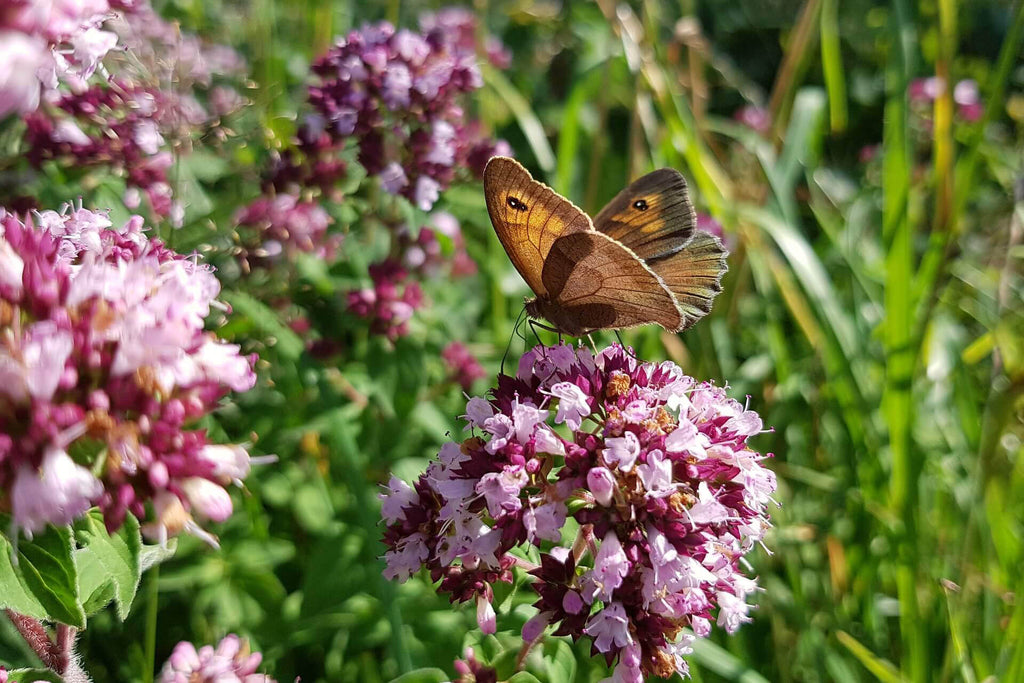Bring Butterflies to Your Garden With Wild Marjoram
Posted by PURE SEEDS

The dainty wings of a butterfly are one of the most beautiful sights in nature. Best of all, it's a sight you can experience in your own back garden. With the right plants you can create a space teeming with wildlife and bring your garden alive. The good news is you don't need a huge space or dozens of plants to attract butterflies to your garden. In fact, just one plant will do! And if you're going to choose any plant, we think it should be wild marjoram.

We're big fans of plants that are useful for wildlife and humans, and wild marjoram ticks both those boxes. The nectar-rich flowers are particularly attractive to butterflies, but will also bring in moths, bees, hoverflies, and other pollinators. As for us humans, this is a wonderful edible plant that can be used as a kitchen herb. Wild marjoram is native to Britain but the same species (Origanum vulgare) can also be found growing in the Mediterranean, where it's known as the herb Oregano. Due to our colder climate the plant develops a different scent, but it's still fantastic for use in cooking.
Wild marjoram also plays a vital role as a caterpillar food plant for several species of butterfly, including the rare British Large Blue. This species is so rare that it actually became extinct in Britain in 1979, but was successfully reintroduced from Europe with careful conservation methods. To find one in your own garden would be a truly wonderful sight!

There are so many reasons to introduce wild marjoram to your garden. As a perennial plant you can sow seed once and enjoy the plant for years to come. It's often said to be the best flower you can grow for attracting pollinators, and you will find it covered in more butterflies and bees than anything else in the garden. The Urban Pollinators blog even said: "If I only had space for one plant to attract pollinators I would plant wild marjoram." You'll also find it mentioned on the RHS Plants for Pollinators list.

How to grow wild marjoram
It's easy to grow wild marjoram from seed! You can sow it at almost any time of year, though you will get the best results in spring and autumn. This is a plant that prefers dry conditions, and thrives in infertile, alkaline soil. Simply choose a spot outside that has good drainage and gets a lot of sunlight, then water the soil and sprinkle your seeds over. If you want to grow wild marjoram in pots, try adding rocks or gravel for drainage. Cover the seeds lightly with compost, and water whenever the soil dries out until your seedlings appear. Thin out your seedlings until they are 20cm (8 inches) apart, and water less frequently as the plant grows.
Once your wild marjoram is well established and has grown big enough, you can start picking leaves to use in the kitchen. This is a great herb for flavouring sauces! Depending on when you started growing your plants, you should get to enjoy the beautiful flower clusters (and all the butterflies and bees they bring!) between June and September. And as this is a perennial plant, you'll be able to enjoy the return of these flowers every year. It's also evergreen, meaning you can pick leaves at any time of year! (Just go easy in the winter, when growth is slower.)

Where to buy wild marjoram seeds
You can buy Wild Marjoram seeds right here on our website! There are two packet sizes to choose from - either 150 seeds or 750 seeds.